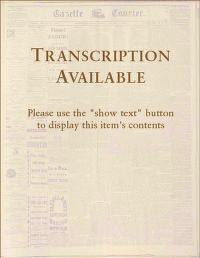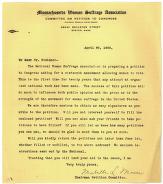|

"Beecher on Female Suffrage" article from Greenfield Gazette and Courier newspaper

"Why Should Suffrage Be Imposed on Women?

Excerpt "On the Condition of Women in the United States" article from The Liberator newspaper

Women Vote article published in Gazette and Courier

Suffrage letter to George Sheldon
|
Summary and Objective
The students will understand that the Women's Suffrage movement had many differing views and this led to interesting debates. Using a graphic organizer the children will research one notable person of the late 19th or early 20th century's suffrage movement. They will research various primary and secondary sources and fill out the graphic organizer at the second/third web site link. The students would then present their person. (Possibilities could include speeches, plays, street encounters, interviews, debates, Seneca Falls replay. Students could present individually or as a group.)
Teaching Plan
Step 1.
Read "Woman Vote" article from the online collection. What do you think of the cereal company collecting women's votes. Why? Is this an accurate method for collecting votes? Explain your thinking.
Step 2.
The students will chose one person who had an opinion on giving women the vote and the best way to go about it. (Susan B. Anthony, Elizabeth Cady Stanton, Lucy Stone, Alice Paul, Julia Ward Howe, Lydia Taft, Frances Wright, Ernestine Rose, Lucretia Mott, Margaret Fuller, Gerrit Smith, Fredrick Douglas, Mary Ann M'Clintock, Paulina Kellogg Wright Davis, Abby Kelley Foster, William Lloyd Garrison, Wendell Phillips, Matilda Joslyn Gage, Sojournor Truth, Carrie Chapman Catt, Harriet Burton Laidlaw) Have items from the Collection printed, books, and internet access The children will take notes using graphic organizers. leader.
Step 3.
For homework the students will write up their notes in the form required by their presentation. Student/students will assume the role of his/her person in skit, speech, letter, or article for a summative evaluation.
Step 4.
As a class, the students will develop a rubric for evaluating the presentations. The students would have rehearsal time.
Step 5.
The children would present their Women's Suffrage figure and be evaluated using the rubric they constructed.
|




